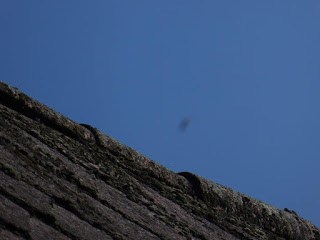Carin's son compared it with Pokemon Go. You try to find as much birds (Pokemon) as possible. And the more special the bird (Pokemon), the better.
It is even possible that your celphone is saying where to go for finding the birds ... euh ... or is it Pokemon.
Some time ago I saw passing a golden eagle (kungsörn - steenarend). 2 raven were flying high in the sky and the eagle was flying above them. Still the raven seemed to be small birds.
This is the first time I see him here. Golden Eagle is a local bird. I see them quite often in the winter along the highways. They feed on the carcasses killed by the cars.
And while I was writing this some time ago, an osprey (fiskgjuse - visarend) showed up, heading straight towards the south. This is a real migratory bird.
Some spotted flycatchers (grå flugsnappare - grauwe vliegenvanger) stayed some time in our garden. Even 2 European pied flycatcher (svartvit flugsnappare - bonte vliegenvanger) joined them. It looked even funny as there were at least 6 or 7 flycatchers in the pear tree in the middle of our lawn. Typical for flycatchers is that they catch something in the air and return to the same place. Multiply this with the number of birds and our peer tree seemed to have sparks flying in all directions.
The flycatchers are gone now. Together with the swallows. The last group was a little group of youngsters who came to say goodbye but now the sky is not any more loaded with their antics. The robins (rödhaka - roodborstje) have taken over.
Erik was here again. Although we did work hard on the farm, we escaped 2 days towards Falsterbo.
Falsterbo is one of the best places in Europe to watch birds in migration time. As good as al the Swedish and Norwegian, and even a part of the Finish migratory birds are passing in this peninsula on 40 minutes drive from our gård (farm).
Each bird has his migration period. In the end of august it was the time for the raptors. So we took 2 white plastic chairs, 3 binoculars, an old telescope and a pocket camera. Especially the second day was really fun. When we left more than 100 people was standing or sitting in a row to see the raptors flying by.
Reports can be found on http://www.falsterbofagelstation.se/
The plastic chairs were not "conventional", but our being in Falsterbo turned out to be a wonderful experience with lots of raptors comming over close or far away.
 |
| At each side a row of birdwatchers focussing on the birdspecies comming over. |






















